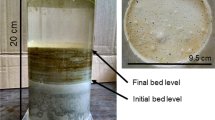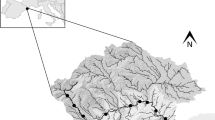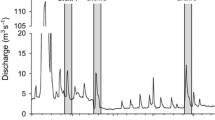Abstract
We investigated possible effects of the hydrodynamics at the water/sediment interface on river bed biofilms within the reservoir Freudenau (Vienna, Austria) of the Danube River during the period 1996/97. Two study sites (OBB and SSF) that differed in the magnitude of surface/subsurface water exchange were selected and intersite comparisons revealed higher organic matter, bacterial cell numbers, and esterase activity in SSF with lower horizontal outflow. Concentrations of colloidal carbohydrates and uronic acids were unaffected by hydrodynamics. The relative contribution of uronic acids to bulk colloidal carbohydrates was higher in the low-flow site SSF. The distribution patterns of this relative contribution generally matched the subsurface flow pattern. Shortly after impoundment in March 1996 and along with decreased surface flow velocity, maximal biofilm carbohydrate exopolymers concurred with minimal esterase activity in OBB. We hypothesize that this inverse relationship is due to increased diffusional resistance within the exopolymer biofilm matrix that reduces mass transfer and hydrolytic activity.
These results, to our knowledge, are the first evidence for microbial participation in the clogging of a large river bed. Biofilm-associated organic carbon increased significantly by a factor of ∼3.3 to 4.4 with progressive clogging as determined by the sediment leakage coefficient, which increased ∼3.8 times. Concomitantly, with ongoing clogging, esterase activity exhibited increasingly higher values at the interface relatively to deeper sediment layers, which translates into steeper depth gradients. Furthermore, minimal inflow from the surface water into the river bed along with steepest esterase gradients concurred with a senescent benthic algal bloom. This suggests an important role for algae in clogging. Either algae obstruct voids mechanically, or their exudates fuel heterotrophic bacteria that in turn are involved in clogging processes. However, our data do not allow unequivocal differentiation between biogenic and physical clogging mechanisms.
Similar content being viewed by others
Author information
Authors and Affiliations
Additional information
Received: 14 September 1998; Accepted: 31 December 1998
Rights and permissions
About this article
Cite this article
Battin, T., Sengschmitt, D. Linking Sediment Biofilms, Hydrodynamics, and River Bed Clogging: Evidence from a Large River. Microb Ecol 37, 185–196 (1999). https://doi.org/10.1007/s002489900142
Issue Date:
DOI: https://doi.org/10.1007/s002489900142




